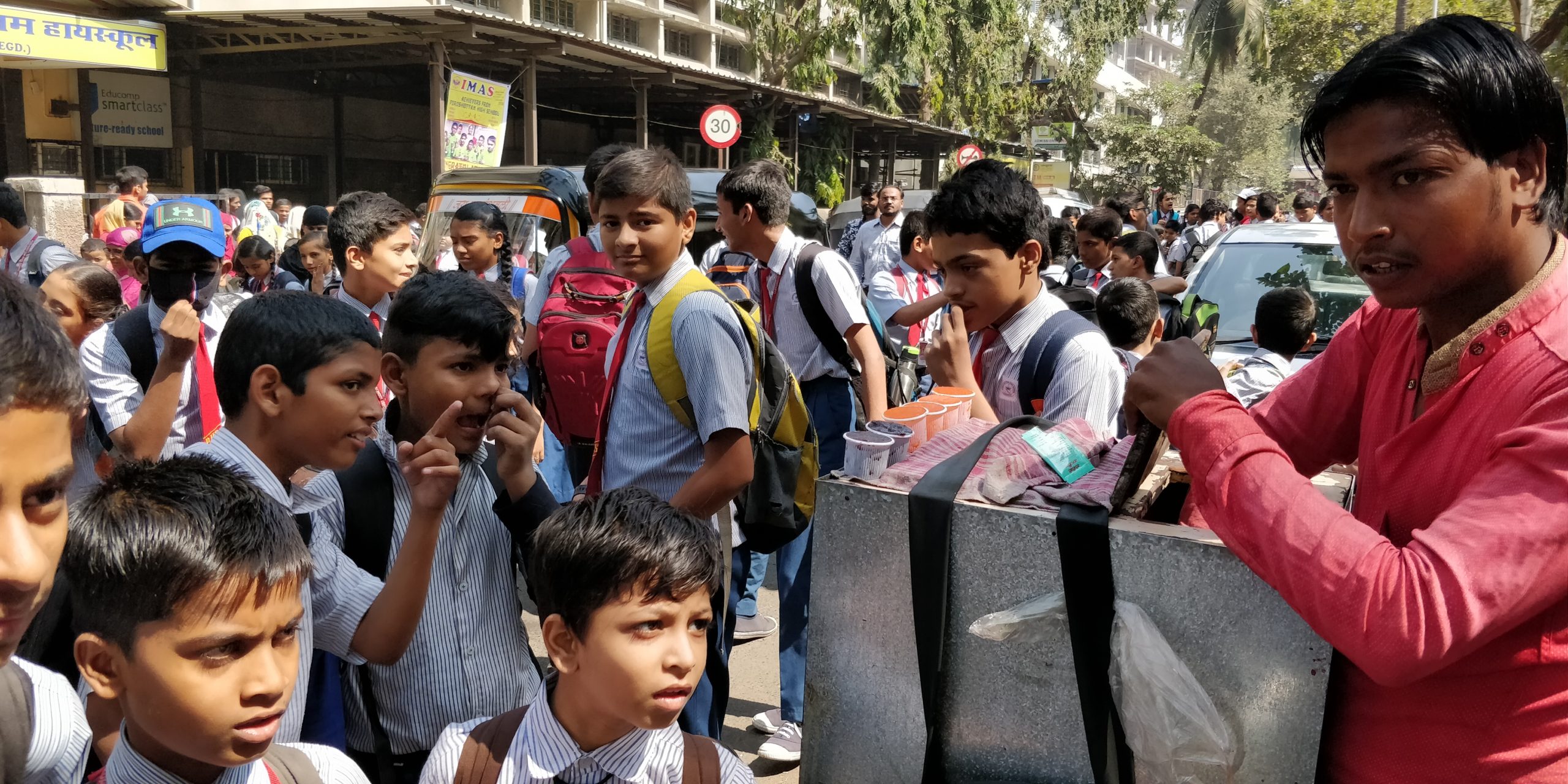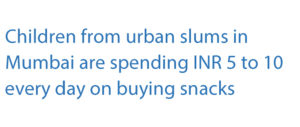Snacking Habits of Urban Low-Income School Going Children: Is there an Opportunity to Impact the Nutrition at the Bottom of the Pyramid?

Shift breaks in schools in and around urban slums in Mumbai provide a unique visual. On a regular day after the shift ends, you can witness hundreds of children coming out and within moments thronging the local street food vendors and Kirana stores. In the next 15-20 minutes, packaged chips, fried snacks, local savories, pickles, and ice candies sell like hot cakes.
We were in front of a municipal school in Dharavi, the largest slum in Asia. It was nearing 12.30pm, time for a shift changeover – when the morning batch of students exit and the afternoon batch of stud ents enter the school. As the morning shift was coming to an end, we saw mobile food vendors gradually flocking near the school gate. These vendors are regular outside the school premises, assemble mostly during the shift changeover period and sell typically locally made 5-Rupee snack items in handheld push carts, portable structures, baskets, etc. We saw a range of unbranded 5-rupee products like local savory items (e.g., Chinese bhel), local kulfi, ice gola (flavoured crushed ice), pickles, lemonade, etc. being sold by the mobile vendors. But these food items hardly qualify as nutritious. However, when the shift ended, we saw hundreds of children coming out of the school and stopping to buy their preferred snack item. We observed a sizable portion of these students “sleepwalking” into the nearby Kirana store and grabbing their favourite chips. The Kirana Stores also store mostly 5-rupee branded chips packs as they feel the children cannot afford anything more than that.
ents enter the school. As the morning shift was coming to an end, we saw mobile food vendors gradually flocking near the school gate. These vendors are regular outside the school premises, assemble mostly during the shift changeover period and sell typically locally made 5-Rupee snack items in handheld push carts, portable structures, baskets, etc. We saw a range of unbranded 5-rupee products like local savory items (e.g., Chinese bhel), local kulfi, ice gola (flavoured crushed ice), pickles, lemonade, etc. being sold by the mobile vendors. But these food items hardly qualify as nutritious. However, when the shift ended, we saw hundreds of children coming out of the school and stopping to buy their preferred snack item. We observed a sizable portion of these students “sleepwalking” into the nearby Kirana store and grabbing their favourite chips. The Kirana Stores also store mostly 5-rupee branded chips packs as they feel the children cannot afford anything more than that.
Shift changeover visuals are almost similar across the schools we visited in and around the urban slums. Usually, there are two to three schools in and around one urban slum settlement where the children from low-income  households go. These are either municipal schools, managed by the local government body and budget private schools managed by a private body. Generally, the opportunity for the snack vendors to intercept these students come 2-3 times a day during the end of each shift. The crescendo for a sea of children coming out of schools and making their purchases normally stay for 15 to 20 mins after each shift ends. The vendors try to make the most during that time.
households go. These are either municipal schools, managed by the local government body and budget private schools managed by a private body. Generally, the opportunity for the snack vendors to intercept these students come 2-3 times a day during the end of each shift. The crescendo for a sea of children coming out of schools and making their purchases normally stay for 15 to 20 mins after each shift ends. The vendors try to make the most during that time.
During interactions most children shared they get INR 5 to 10 per day as pocket money from home which they spend  on snacking after their school gets over. Interestingly those who get INR 10, tend to distribute the money and buy more than one products, usually spreading their purchases over different times of the day. But currently, the children do not have a nutritious option for snacking. Presently, either they go for a locally made unbranded product which has low nutritional value, and questionable hygiene levels or they throng around Kirana stores to buy branded fried chips.
on snacking after their school gets over. Interestingly those who get INR 10, tend to distribute the money and buy more than one products, usually spreading their purchases over different times of the day. But currently, the children do not have a nutritious option for snacking. Presently, either they go for a locally made unbranded product which has low nutritional value, and questionable hygiene levels or they throng around Kirana stores to buy branded fried chips.
We see an opportunity to innovate and impact the nutrition of these 6 to 17-year-old children who are from the  nearby slums and regularly munch on branded and unbranded snack products. Private Sector firms can take the lead in developing innovative business and product ideas and impact nutrition at base of the pyramid. Leveraging existing market reach, distribution and retail channels, and product R & D resources, interventions from private sector will help bring in a sustainable solution with scale to transform the problem into an opportunity.
nearby slums and regularly munch on branded and unbranded snack products. Private Sector firms can take the lead in developing innovative business and product ideas and impact nutrition at base of the pyramid. Leveraging existing market reach, distribution and retail channels, and product R & D resources, interventions from private sector will help bring in a sustainable solution with scale to transform the problem into an opportunity.












